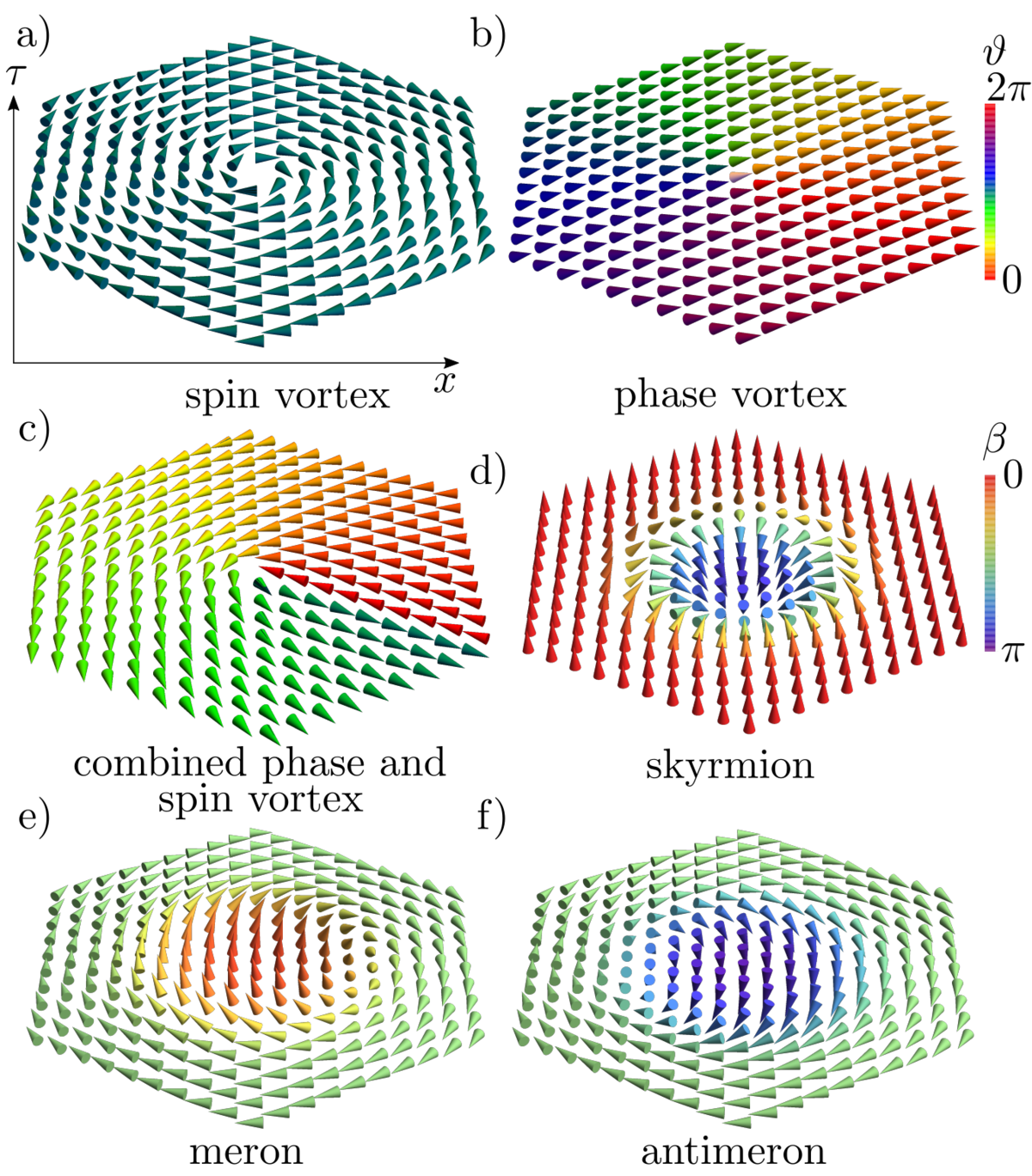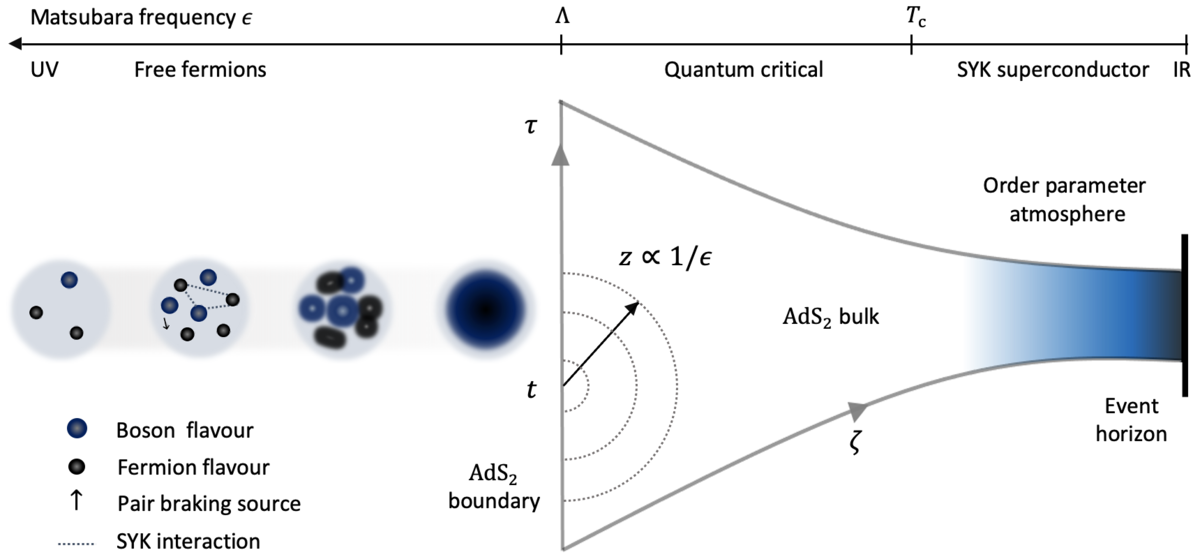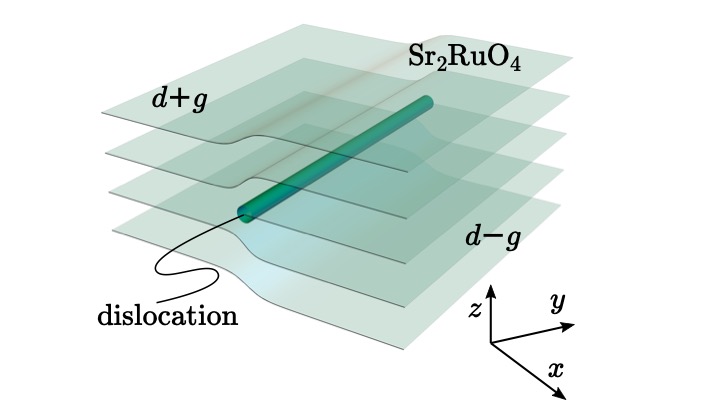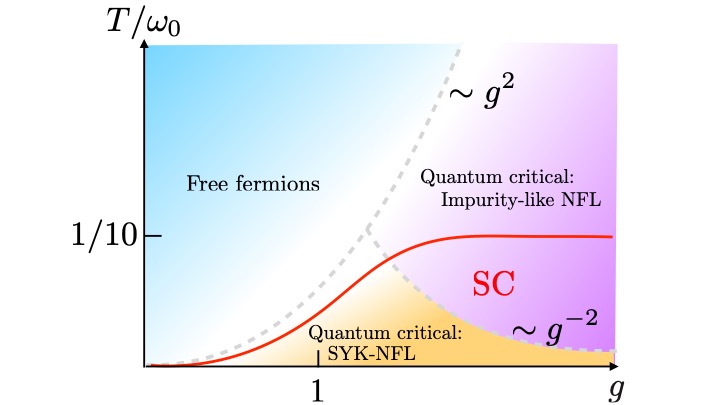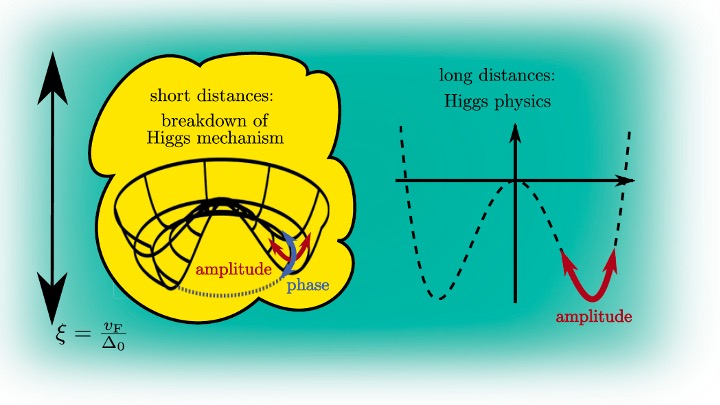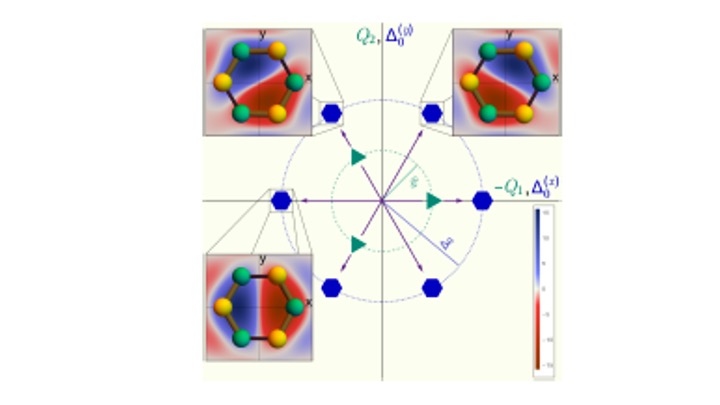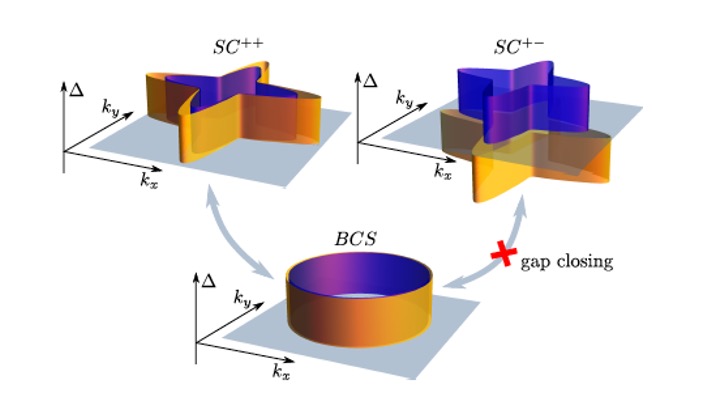Theory of superconductivity
Our research activities in the theory of superconductivity are partly supported by the DFG transregional collaborative research center TRR-288.
The superconducting state constitutes one of the most fascinating ordered states of quantum matter. Our research activities are primarily concerned with various aspects of unconventional pairing states and with the question of supercondutivity without quasiparticles.
Superconductivity without quasiparticles
Superconductivity is the ultimate fate of a Fermi liquid at low temperatures. Since superconductivity occurs in many systems where sharp Fermi liquid quasiparticle excitations are absent, the conditions for pairing of incoherent electrons is an important problem in condensed matter physics. Key questions in this context are: Can one form Cooper pairs from completely incoherent fermions? What is the role of quantum criticality for pairing? Are there sharp quasiparticles in such a superconductor? Is the Cooper pair fluid that emerges still an ideal gas of pairs?
We have addressed these questions by analyzing the pairing problem in electronic systems near quantum critical points, pairing due to valence-skipping charge-Kondo impurities, and the RVB-pairing in doped Mott insulators for organic charge transfer salts and a doped valence bond state. Most recently, we demonstrated that critical and even fully incoherent electrons are undergo superconductivity, yet with reduced weight of the Bogoliubov quasiparticle weight and reduced superfluid stiffness. These results were obtained from the solution of a generalization of the Sachdev-Ye-Kitaev model to systems with strong electron-boson coupling. In particular, we were able to derive the gravitational theory of a holographic superconductor from the SYK model, which demonstrates that quantum critical Eliashberg theory and holographic superconductiviry are distinct perpectives of the same physical phenomenon.
Superconducting fluctuations, topological superconductivity, disorder in superconductors
We address a range of problems in the context of the theory of superconductivity. We proposed that topological superconductivity serves as indicator for unconventional pairing states in oxide interfaces, determined Cooper pair selection rules in systems with broken inversion symmetry, or showed that the Higgs mechanism in superconductors breaks down for length scales shorter than the superconducting coherence length due to the composite nature of the Higgs field, i.e due to the finite binding energy of Cooper pairs. The breakdown of the Higgs mechanism inside the superconducting coherence volume is crucial to ensure the stability of the BCS mean-field theory in the weak-coupling limit. We also analyzed the impact of impurity scattering in a number of multi-band superconductors, identifying generalizations of the Anderson theorem to unconventional pairing states. For one dimensional topological triplet superconductors we demonstrated dynamical zero modes enable algebraic charge-2e superconductivity, which is destroyed by fluctuations in non-topological superconductors.
Return to the research group - strongly correlated electrons.
Selected Publications (superconductiviry without quasiparticles)
- Quantum critical Eliashberg theory, the SYK superconductor and their holographic duals, G.-A. Inkof, K. Schalm, and J. Schmalian, https://arxiv.org/abs/2108.11392
- Eliashberg equations for an electron–phonon version of the Sachdev–Ye–Kitaev model: Pair breaking in non-Fermi liquid superconductors, D. Hauck, M. J. Klug, I. Esterlis, and J. Schmalian, Annals of Physics 417, 168120 (2020). https://arxiv.org/abs/1911.04328
- Pairing glue in cuprate superconductors from the self-energy revealed via machine learning, A. V. Chubukov and J. Schmalian, Physical Review B Rapid Communications 101, 180510(R) (2020). https://arxiv.org/abs/2002.02994
- Cooper pairing of incoherent electrons: An electron-phonon version of the Sachdev-Ye-Kitaev model, I. Esterlis and J. Schmalian, Physical Review B 100, 115132 (2019). Editors’ suggestion https://arxiv.org/abs/1906.04747
- Disentangling Cooper-pair formation above the transition temperature from the pseudogap state in the cuprates, T. Kondo, Y. Hamaya, A. D. Palczewski, T. Takeuchi, J. S. Wen, Z. J. Xu, G. Gu, J. Schmalian, and A. Kaminski, Nature Physics 7, 21 (2011). [Featured in Nature Physics News and Views, by Dirk van der Marel, Nature Physics 7, 10 (2011)]
- Quantum phases in a doped Mott insulator on the Shastry-Sutherland lattice, J. Liu, N. Trivedi, Y.-B. Lee, B.-N. Harmon, and J. Schmalian, Physical Review Letters 99, 227003 (2007). https://arxiv.org/abs/cond-mat/0702118
- Strong coupling superconductivity due to massless boson exchange in the strong-coupling limit, A. Chubukov and J. Schmalian, Physical Review B 72, 174520 (2005). https://arxiv.org/abs/cond-mat/0507562
- Pairing and superconductivity driven by strong quasiparticle renormalization in two-dimensional organic charge transfer salts, J. Liu, J. Schmalian, N. Trivedi, Physical Review Letters 94, 127003 (2005). https://arxiv.org/abs/cond-mat/0411044
- Superconductivity in charge Kondo systems, M. Dzero, J. Schmalian Physical Review Letters 94, 157003 (2005). https://arxiv.org/abs/cond-mat/0409171
- Quantum-critical theory of the spin-fermion model and its application to cuprates: normal state analysis. Ar. Abanov, A. V. Chubukov, J. Schmalian, Advances in Physics 52, 119-218 (2003). https://arxiv.org/abs/cond-mat/0107421
- Quantum critical pairing in cuprates, Ar. Abanov, A. Chubukov, and J. Schmalian, Europhysics Letters 55, 369 (2001). https://arxiv.org/abs/cond-mat/0005163
- Fingerprints for spin-mediated pairing in cuprates Ar. Abanov, A. Chubukov and J. Schmalian, Journal of Electron Spectroscopy and Related Phenomena 117, 129 (2001). https://arxiv.org/abs/cond-mat/0010403
Selected publications (superconducting fluctuations etc.)
-
Topologically enabled superconductivity, M. Rampp, E. König, and J. Schmalian, https://arxiv.org/abs/2108.05360
-
Inhomogeneous time-reversal symmetry breaking in Sr2RuO4, R. Willa, M. Hecker, R. M. Fernandes, J. Schmalian, Phys. Rev. B 104, 024511 (2021). https://arxiv.org/abs/2011.01941
- Z3-vestigial nematic order due to superconducting fluctuations in the doped topological insulators NbxBi2Se3 and CuxBi2Se3, C.-w. Cho, J. Shen, J. Lyu, O. Atanov, Q. Chen, S. H. Lee, Y. S. Hor, D. J. Gawryluk, E. Pomjakushina, M. Bartkowiak, M. Hecker, J. Schmalian, and R. Lortz, Nature Communications 11, 3056 (2020). https://arxiv.org/abs/1905.01702
- Friedel oscillations and Majorana zero modes in inhomogeneous superconductors, L. Lauke, M. S. Scheurer, A. Poenicke, and J. Schmalian, Physical Review B 98, 134502 (2018), https://arxiv.org/abs/1803.11421
- Vestigial nematic order and superconductivity in the doped topological insulator CuxBi2Se3, M. Hecker and J. Schmalian, npj Quantum Materials 3, 196801 (2018). https://arxiv.org/abs/1712.07523
- Role of fluctuations for density-wave instabilities: Failure of the mean-field description, M. Hoyer and J. Schmalian, Physical Review B 97, 224423 (2018). https://arxiv.org/abs/1712.04679
- Short-distance breakdown of the Higgs mechanism and the robustness of the BCS theory for charged superconductors, S. Fischer, M. Hecker, M. Hoyer, and J. Schmalian, Physical Review B 97, 054510 (2018). https://arxiv.org/abs/1711.11382
- Selection rules for Cooper pairing in two-dimensional interfaces and sheets, M. S. Scheurer, D. F. Agterberg, and J. Schmalian, npj Quantum Materials 2, 9 (2017). https://arxiv.org/abs/1503.03646
- Locking of length scales in two-band superconductors, M. Ichioka, V. G. Kogan, and J. Schmalian, Physical Review B 95, 064512 (2017). https://arxiv.org/abs/1610.00136
- Charge doping versus impurity scattering in chemically substituted iron pnictides, A. Herbig, R. Heid, J. Schmalian, Physical Review B 94, 094512 (2016) https://arxiv.org/abs/1510.06941
- Concealed d-wave pairs in the s±-condensate of iron-based superconductors, T. Ong, P. Coleman, and J. Schmalian, Proceedings of the National Academy of Sciences 113, 5486 (2016). https://arxiv.org/abs/1410.3554
- Disorder-promoted C4-symmetric magnetic order in iron-based superconductors, M. Hoyer, R. M. Fernandes, A. Levchenko, and J. Schmalian Physical Review B 93, 144414, (2016). https://arxiv.org/abs/1512.05747
- Pair breaking in multiorbital superconductors: An application to oxide interfaces, M. S. Scheurer, M. Hoyer, and J. Schmalian, Physical Review B 92, 014518 (2015). https://arxiv.org/abs/1505.04919
- Pair breaking due to orbital magnetism in iron-based superconductors, M. Hoyer, M. S. Scheurer, S. V. Syzranov, and J. Schmalian, Physical Review B 91, 054501 (2015). https://arxiv.org/abs/1410.2555
- Topological Superconductivity and Unconventional Pairing in Oxide Interfaces, M. Scheurer and J. Schmalian, Nature Communications 6, 6005 (2015). https://arxiv.org/abs/1404.4039
- Effect of weak disorder on the phase competition in iron pnictides, M. Hoyer, S. V. Syzranov, and J. Schmalian, Physical Review B 89, 214504 (2014). https://arxiv.org/abs/1403.6103

